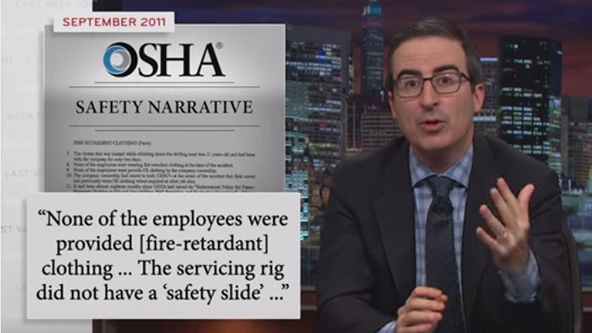Mainstream news outlets are bringing unprecedented attention to safety concerns surrounding North Dakota’s oil and gas industries. This attention has upped the pressure on OSHA to take action, which, depending on the scope of the agency's reaction, has the potential to impact oil and gas operations not only in North Dakota, but in other states and locations as well.
This summer and fall, PBS is airing a new documentary called The Overnighters which profiles the impact of the oil boom, including dangers faced by oil workers. Just last weekend, the HBO comedy show Last Week Tonight with John Oliver devoted its main segment [warning: NSFW language] to oil and gas workers in North Dakota, and was especially critical of OSHA’s enforcement efforts in the region (pointing out that there are only eight inspectors assigned to the entire state, out of about 2,200 nationally).
This new attention adds to already existing media surrounding the North Dakota oil and gas industry, including:
- Black Gold Boom the award-winning documentary funded by the MacArthur Foundation, the NEA, and several public broadcasting entities.
- The 2014 film White Earth about the challenges of the North Dakota oil boom, a 2015 Oscar nominee for Best Documentary Short Subject.
- The new ABC television series Blood and Oil, a prime time drama about the North Dakota oil boom.
Not all of this media is focused on safety dangers faced by workers, but much of it is.
So, is this new attention justified?
A 2015 report compiled by the AFL-CIO showed that North Dakota had the highest on-the-job fatality rate of any state in the nation, at 14.9 per 100,000 workers. The fatality rate for North Dakota oil and gas workers was even higher; an astonishing 84.7 per 100,000. (In contrast, the national fatality rate for oil and gas workers is 12.4 per 100,000.) North Dakota’s on-the-job fatality rate has more than doubled since 2007, at the start of the boom.
What about the criticisms leveled at OSHA’s work in the region?
In Mid-2014, OSHA acknowledged its challenges in North Dakota and announced a new enforcement program specifically designed to target high-hazard industries in the state. OSHA said the program would temporarily bring in additional investigators from around the country to increase inspector field presence. (It did not divulge how long these temporary additional investigators would remain, or exactly how many there were.) OSHA pointed out that in 2012, about two-thirds of the fatal accidents in North Dakota jobsites were in the oil and gas industry, and the remainder were in construction.
“These industries are inherently dangerous, and workers are exposed to multiple hazards every day,” Eric Brooks, OSHA's area director in Bismarck, said in a press release. “Their safety must not be compromised because demand for production keeps increasing. Workers are coming to these growing industries to find jobs, not catastrophic injury and preventable death. These employers have a legal responsibility to protect every employee that works for them.”
In fairness to OSHA, it is not the only federal agency struggling to figure out how to handle this unprecedented growth in North Dakota — that has, in some cases, doubled the population and per capita incomes of entire counties in the span of just four or five years. For example, last year the FBI said it had agreed to deploy additional agents to North Dakota and Montana to deal with surges in crime accompanying the boom.
So far, it’s unclear if this new wave of media attention will impact safety regulation or enforcement. Nevertheless, industry observers looking for insight into OSHA's priorities and enforcement tools should keep an eye on developments in North Dakota. Things can change quickly. Stay tuned!







